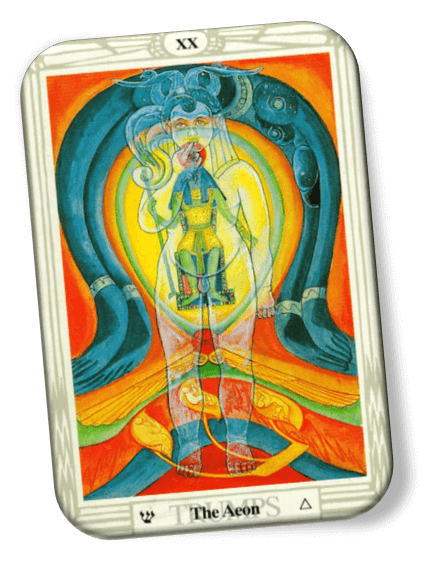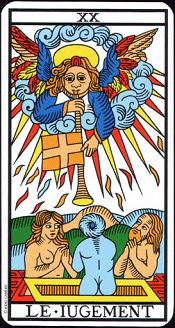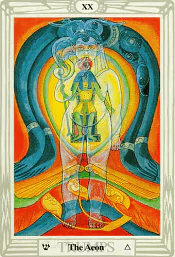The Aeon Thoth – Crowley Tarot | Thoth Tarot Deck
| Birth, rebirth, awakening, awareness of utopia. | |
| Birth, rebirth, awakening, awareness of utopia. | |
| Recognize the great correlations, expanded perceptions and the liberation of previously hidden powers. | |
| Misidentification, self-deception, megalomania. | |
| The transformation. |
Menu of Contents
I. Background of the Aeon Thoth Tarot card
1. The Aeon Thoth Tarot card
The Nut Goddess that Crowley called “the symbol of endless possibilities”, contrary to the charming form of “fairy star”, is not expressed in human form, “but part of the sky”. The Goddess of the sky showed herself like a green frame shining in space, an upside-down egg of light. This typical essence corresponds to her code and also means a uterus or vase. According to Crowley, the upside-down and winged egg symbolizes Nut’s lover, the man he calls Hadit.
From the usual legend, Crowley thinks that the child Harpokrates (childish Horus) in the foreground is the connection of Nut and Hadit. However, this child is not only the embodiment of the connection between the concept (Hadit) and the ability (Nut) but also the vertical cut through time (connecting the past and the future). This is seen in the Haroeris character in the center (adult Horis) in the background, the person who reaches out of the past to enter the uncertain present and can become the future. Dual Horus, on a deeper level, symbolizes the beginning that created itself from the end and is the symbol of the end that has emerged from the beginning: the nature of time.
2. Aeon (new era)
Nut, Hadit and Hoor-pa-kraat (= Hapokrates = the child Horus) are three Gods who have read to Crowley the “Book of the Law” through Aiwass, extraterrestrial intelligence. He accepted it at noon from April 8 to April 10, 1904, in Cairo and declared the beginning of a new era: Horus’s era will now replace the era of the dying God (Osiris). The Aion of Persia that Aeon, the name of this card, based on his name, is an icon of the time of the world as the earliest appearance, but also signifies the age as well as the eternity. The great day is celebrated every year on the 6th of January in the temple of Kore in Alexandria because Kore gave birth to Aion, the God of eternity, on this day. Heraclitus talks about him: “He is a child, playing like a child assembling pieces together. The rule belongs to a child. ”
II. Analyze and describe the Aeon Thoth Tarot

1. Motif (heavenly eggs)
a. Nut, Hadit, Hoor-pa-kraat, and Ra-hoor-khuit
Completely keeping Egyptian legends, Crowley blends mythological characters that are inherently separate. Horus (Appolo in Greece) was originally the son of the Goddess of the sky (Greece – Rhea) with her husband, the god Geh (Greek – Cronos) was born. At the same time, Nut gave birth to five children, Horus was the brother of Isis, Osiris, Seth (Greek – Typhon) and Nephthys. Thus, he is considered a falcon and the God of the world, light, and sky. His Egyptian name was Heru which became Harachte (“Horus from the horizon”) and described him as a God of the rising morning sun. He was then inputted into the God of Sun, Re, as a character and named Re Haracte that Crowley transliterated into Ra-hoorit.
On the other hand, Osiris mythology tells that Horus was the son that Isis conceived from the dying God Osiris (some sources still claim to be dead). His name is Hoor-pa-kraat (Greek-Harpokrates) meaning “Horus child”. He was portrayed as a sun child, sitting on a lotus blooming and sucking his thumb. However, as in the Aeon Thoth card, it is common to see him standing with his index finger in his mouth. Because Egyptian mythology later described that Nut, the Goddess of the sky, gradually grew to become a great Goddess with the sacred cow Hathor and the goddess Isis, Crowley merged those myths by calling Nut/Isis the mother who brought Horus to this world. He then appeared as “the childish Horus” and “adult Horus”.
There is only one problem that needs to be clarified which is the child’s father. Those who are considered: Osiris, Haporkrates’s dying father, Geb, Nut’s husband, or Re, the Sun God and Nut’s lover, who, according to Plutarch, is the father of two of the five children, Osiris and Horus. Most likely, Geb, his Egyptian name is sometimes written with the “egg” symbol and some people consider he was the first God to lay down the world egg, corresponding to his portrait, is an egg in the Aeon Thoth card.
The winged sun on the top of the egg turned upside down defending the Sun God Re who Crowley called Hadit’s father and said he was Nut’s lover. However, we are not familiar with this name. Hadit means light in ancient Egyptian, and in language related to Hai, a term that refers to the sun God with “the brilliant”: “Hadit” is the name that the Arab alchemists place for iron elements, and in turn, it corresponds to Seth. Perhaps, it was Crowley’s allusion, making Seth – the “antagonistic” character becomes Nut’s lover, reinforced by the portrait of the common child as a snake in Atu XXI.
b. Nut/Isis
Nut, who is seen on par with Hathor and Isis, embodies the sky. She was a sacred cow leaning towards her husband, the God of Geb, during the day and going down at night to reunite with him. It was her who gave birth to the Gods, and the Egyptians talked about how she had swallowed the sun every night in the west and gave birth to him again from her body every morning. Her blood fell in the process of coloring the morning sky with the red sun rising. She is a great mother who gives life and then retracts it into her body. The coffin and tombstone are also called Nut because the dead are again in Nut’s body. We see her as the blue character in the Aeon Thoth card, bending like a bell when it wraps around the golden egg. She was the ruler that brought time and then regained it.
c. Hadit
The Egyptians considered the golden egg as the fruit of Isis (Nut). In this card, it is the egg of light or fireball lying on the safety of the Goddess of the sky. This shining ball, filling the whole sky, is also the universe, Hadit. Crowley said that he was a popular view all over the world and was the concept of the only Realism that is philosophically stable, here, was equivalent to the stand in the truest meaning of the word.
2. Horus (dual character)
Horus, the ruler of the new era, who reflected both sides of man in his double image, was born of the unity of the contrary, the fiery masculine power of Hadit with Nut’s blue water. Physically, he was Re-Harachte and was found in the light egg of Hadit, mentally, he was the young and pure power of Harpokrates, who demanded silence.
a. Adult Horus (Ra-hoor-khuit/Re-Harachte)
On the inner side (solar network) we see Ra-hoor-khuit as a symbol of tough power. The Pharaohs themselves claimed to be the Eagle God and was worshiped as his being. He carried a plate of the sun on his head and told himself, according to Crowley: “I am the Lord of the dual chopsticks of power; Coph Nia’s power chopsticks; but my left hand is empty because I have crushed a universe, and nothing else.
b. Childish Horus (Hoor-pa-kraat/Harpokrates)
Harpokrates is the child that Isis conceives from a dying God, some legends have said that he died – Osiris. He was considered sick, and his life was occasionally threatened. As a valid successor to the throne, the son had a difficult and tiring struggle with his uncle Seth (cruel), who also claimed succession. In the end, his mother, Isis, had to make a trick to have a decisive breakthrough and secure his throne. Harpokrates are often drawn like a baby with an index finger on his lips. So, he was seen as a silent God following the Greeks and Romans, but the Egyptians continued to deny enthusiastically. They still keep the image of him being a baby sucking his thumb. The strange thing is that he is often shown with his index finger on his lips rather than with the thumb. It seems like he is making a gesture of initiation.
The two Uranus snakes on his head always protect him in danger, the boy represents a new and better era, and according to Crowley, is a new coming era. In ancient times, he was worshiped as a snake charmer, a sacred healer, a North Star God, who overcame darkness and drought, the embodiment of eternal youth, is the fresh green color of the grass, and is the power to lead souls away from the night, death and insecurity to get into the happy house. In addition, he symbolizes the young, weak and incomplete spiritual aspect of the new era standing in the foreground regardless of that, on the contrary, the old Horus’s authoritarian power must step down.
3. Surrounding fields (other symbols)
a. Shin
In the lower part of the Aeon Thoth card, we see three branches of Shin in Hebrew (“teeth”) in the form of the stamen. Its bags are “filled” with three figures: a child, an adult, and an elderly person. They symbolize life and signify body, soul, and spirit (unconsciousness, consciousness and superconscious). With its numerical value of 300, the word Shin represents “the soul of the Lord”, and the bags that symbolize the wombs within which their protective shells, the spirit of God adapts to the image of the human race – or vice versa. “Thus, God created man in the image of himself; in the image of God who created Him”. However, we should also consider what a skeptical person on the threshold of the new era fears:
The sprouts of the future have flown in polluted air under the sky with holes in the ozone layer. Only a sad glance of God with his cosmic rays penetrates into the punctured atmosphere and observe our mundane pursuits with resignation. If the germ is poisoned as soon as it is formed, the hope is placed in the incomplete emptiness (Zoltan Szabo).
b. Wavy lines (Libra symbol)
Behind Shin is an iconic representation of the Libra, a prediction of the next Aeon in the current two thousand years – “The Fall of the Great Breakdown”; when Hrumachis will rise up and the one who has two wishes will occupy my throne and place (Crowley) – and rule over the midst of the sky”.
4. Note
New Era
As for Crowley, Horus’s era began with his revelation in the “Book of Law” in 1904. It followed Osiris’s 2000-year-old era. Being loyal to the meaning of this event, he introduced a new chronology developed by his followers, the Thelemites in which years are combined into units consisting of number 22 called “I” and the corresponding part is then included using proven Roman numerals. So, 1990 is IIIXX (III = 3 × 22 = 66, XX = 20, its result is 1904 +66 + 20 = 1990). Because this method is not correctly recognized as the simplest, the expression of time that uses traditional chronology with the addition of e.v. (era vulga = common age) was established.
III. Interpretation of the Aeon Thoth Tarot
1. Background of the Aeon Thoth Tarot
The traditional representative of this card is called “the Judgment” or “the Angel” and shows an angel of revival trumpeting with a flag carrying a cross-shaped symbol. At the end of the Aeon Thoth card, we can see an opened grave, from which a corpse emerged. Crowley identified the cross flag as the symbol of the Osiris era (the age of the crucified or hanged Gods) and insisted that these old images must be replaced by a new one, showing a lord will rule for the next 2000 years with the dawn of the new Horus era in 1904.
2. Overview of the Aeon Thoth Tarot
On the highest level, the Aeon Thoth card discusses time and change over time; therefore, it not only discusses the end and destruction, but also about hope, redemption, and liberation. While the traditional cards represent the moving experience of the revival and liberation of the buried and confined, this card pays more attention to the new, the coming in the future and about the utopia that was realized. The spiritual side of the experience is extremely important, and there is a clear human figure in the foreground, on the contrary, Horus is obviously older to back down.
So, the Aeon Thoth card has a completely happy meaning. It shows the decisive step towards its nature and the continuous transformation process in alchemy that makes something higher is created on the basis of it.
3. Awareness
In the deepest part of the soul, the Aeon Thoth card represents a period of insight into the eternal cycles of coming and going. It shows the beginning of the new which already carries in it the end because the power of the coming in the future has been stirred up in the earth. The card directs us to new development, a new life and in that process, it emphasizes the a priori aspect of connecting with a higher self that is likely to occur.
We almost assume that complete liberation from the suffering of this world is an illusion. After all, God’s iconic exemplary life does not end in happiness but on the cross. The purpose of being an idea is important, but the more essential thing is action to reach that goal. It fills the time of life with one purpose. (C.G. Jung).
4. Career
The Aeon Thoth card represents a new way of thinking in our career experience. It often appears in connection with new jobs, new beginnings, and outdated positions that are rejected. Attention is no longer placed on individual parts of the whole, but in the arrangement between them so that the cooperation works smoothly. Even if this card does not seem to have the context of a career change, it is also a sign of “a new age.”
5. Relationship
In our personal connection, the Aeon Thoth card represents the recovery and liberation and implies the power to let new things come to while the old contradictions are united in harmony. It always represents a fresh start in existing relationships, or in connection with a new partner in life. On the other hand, this card also naturally means that the relationship will be enriched by a child.
More The Judgment Cards from Famous Tarot Decks
1. The Judgment Rider Waite Tarot Deck
The Judgement Rider Waite Tarot shows some of naked men, women, and child rising from their own graves, their hands extended toward Archangel Gabriel who is blowing the trumpet above them.
<< See More >> The Judgement Rider Waite Tarot Card Meanings
2. Le Jugement Tarot De Marseille

Le Jugement Tarot de Marseille often reminds a situation where a person knows the birth. This includes many possibilities, such as a difficult outrage, pregnancy disorder, or a difficult situation during childbirth that can cause problems.
<< See More >> Le Jugement Tarot de Marseilles Tarot Card Meanings
3. The Beyond Illusion Osho Zen Tarot Deck
The Beyond Illusion Osho Zen reminds us not to look at the surface of the fact, but to look within it. When we “judge the book by its cover”, we are usually affected by the thoughts that – this is good, this is bad, I want this, I do not want that.
<< See More >> The Beyond Illusion Osho Zen Tarot Card Meanings

